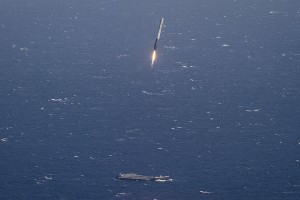Rocket Lands on a Boat and Delivers a Beach Ball to Space
April 12, 2016

A Falcon 9 rocket about to land on a drone ship in the Atlantic Ocean on April 8, 2016. Credit: SpaceX
On Friday, April 8, Space Exploration Technologies Corporation (commonly called SpaceX) landed the first stage of one of its Falcon 9 rockets on a drone ship (uncrewed barge) in middle of the Atlantic Ocean. It was the first landing of its kind in history. Not only the rocket itself but also the payload it sent into space may revolutionize space exploration.
A rocket is a type of engine that pushes itself forward or upward by producing thrust. Unlike a jet engine, which draws in outside air, a rocket engine uses only the substances carried within it. As a result, a rocket can operate in outer space, where there is no air.
SpaceX is a private space exploration company founded by the South African entrepreneur (business developer) Elon Musk. On Friday, one of the company’s multistage Falcon 9 rockets lifted off from Cape Canaveral Air Force Station in Florida. In a traditional multistage rocket, discarded stages fall to Earth or burn up in the atmosphere. On Friday, however, the first stage of SpaceX’s rocket descended back to Earth, used its engines to slow itself, and landed vertically on the drone ship named Of Course I Still Love You.
The April 8 landing came after four unsuccessful attempts by SpaceX over the past year and a half. At the end of 2015, both SpaceX and Blue Origin, a rocket company owned by the American businessman Jeff Bezos, both successfully landed used stages on the ground. These landings marked a major milestone in efforts to build reusable rockets, but SpaceX’s drone ship landing may prove to be even more significant. The trajectory (curved path of flight) of a rocket’s launch usually takes it over the ocean when the first stage separates. Thus, it takes less fuel for a discarded first stage to land on a ship in the ocean than to reverse course and land back near the launch pad. Due to the weight of their payloads, few Falcon 9 first stages will have enough leftover fuel to fly back to land, but most will have enough to attempt a sea landing.
Initial inspections revealed no major damage to the landed first stage. SpaceX hopes to reuse it in a new launch as early as June. If the company is able to routinely make such landings, it will slash the cost of delivering cargo to space. It will also strengthen the confidence of the National Aeronautics and Space Administration (NASA) in the corporation. NASA awarded SpaceX a contract to resupply the International Space Station (ISS). SpaceX’s last attempt to do so ended in failure when the Falcon 9 exploded shortly after takeoff in June 2015.
In another potential boon for private space exploration, SpaceX’s Dragon capsule brought a new module to the ISS. If most space station modules are like giant aluminum cans, the Bigelow Expandable Activity Module (BEAM), created by the American company Bigelow Aerospace, is more like a giant beach ball. It has no rigid frame and was packed in the unpressurized “trunk” of the Dragon capsule. After the new module is connected to the ISS and inflated, astronauts will study and test it for two years. If the tests are successful, Bigelow plans to launch large inflatable modules into space and rent them to governments or corporations looking to perform experiments, manufacture products, or send tourists. Together, SpaceX’s and Bigelow’s innovations promise to make near-Earth orbit more accessible.
Other World Book articles


